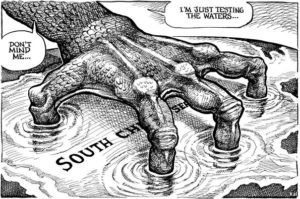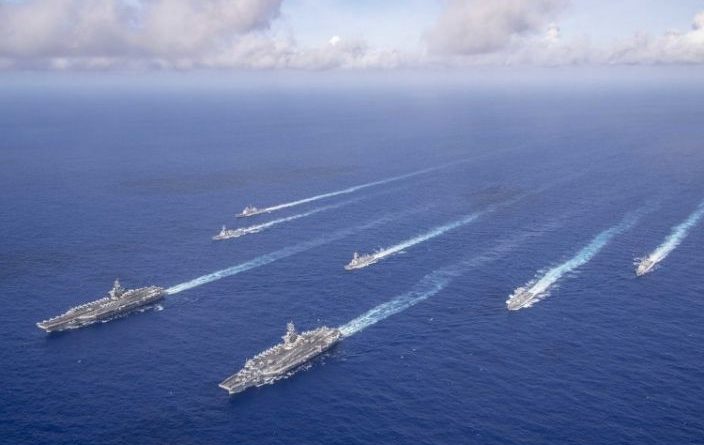THE DAILY PLANET: US carriers drill after Southeast Asian nations rebuke China
PHILIPPINE SEA (June 23, 2020). The Theodore Roosevelt Carrier Strike Group transits in formation with the Nimitz Carrier Strike Group while conducting dual carrier and airwing operations in the Philippine Sea June 23, 2020. Dual carrier operations unify the tactical power of two individual carrier strike groups, providing fleet commanders with an unmatched, unified credible combat force capable of operating indefinitely. The Nimitz and Theodore Roosevelt carrier strike groups are on scheduled deployments to the Indo-Pacific. (Photo: Mass Communication Specialist Seaman Dylan Lavin/U.S. 7th Fleet)
.
.



.
BEIJING (AP) — A look at recent developments in the South China Sea, where China is pitted against smaller neighbors in multiple territorial disputes over islands, coral reefs and lagoons. The waters are a major shipping route for global commerce and are rich in fish and possible oil and gas reserves.
___
US CARRIER STRIKE GROUPS DRILL
Two U.S. Navy aircraft carrier strike groups are conducting dual operations in the Philippine Sea in a show of the service’s ability to rapidly deploy overwhelming force in support of allies locked in disputes with China.
Ships and aircraft assigned to the Nimitz and Ronald Reagan groups began the drills Sunday, the U.S. 7th Fleet responsible for operations in the Indo-Pacific said in a news release.
“Dual carrier operations demonstrate our commitment to regional allies … and our readiness to confront all those who challenge international norms,” Rear Admiral George Wikoff, commander Carrier Strike Group 5, was quoted as saying.
“The U.S. Navy regularly conducts integrated strike group operations to support a free and open Indo-Pacific, and promote an international rules-based order wherein each country can reach its potential without sacrificing national sovereignty,” the release said.
.
..
___
ASEAN LEADERS REBUKE CHINA
Southeast Asian leaders have issued one of their strongest ever statements opposing China’s claim to virtually the entire disputed waters on historical grounds.
The leaders of the Association of Southeast Asian Nations took the position in a statement issued by Vietnam on Saturday on behalf of the 10-nation bloc.
“We reaffirmed that the 1982 UNCLOS is the basis for determining maritime entitlements, sovereign rights, jurisdiction and legitimate interests over maritime zones,” the ASEAN statement said.
The leaders were referring to the United Nations Convention on the Law of the Sea that defines the rights of nations to the world’s oceans and demarcates exclusive economic zones where coastal states are given the right to exclusively tap fishery and fuel resources.
Three Southeast Asian diplomats told The Associated Press the statement marked a significant strengthening of the regional bloc’s assertion of the rule of law in a disputed region that has long been regarded as an Asian flash point. China has been seen as seeking to block such statements by calling on support from Cambodia and other allies within ASEAN.
.
..
___
PHILIPPINES WARNS ON CHINESE ADIZ
Philippine Defense Secretary Delfin Lorenzana is warning that any move by China to establish an air defense identification zone over the South China Sea would be highly destabilizing.
“It is my fervent hope that China would not proceed with this planned action for the continued peace and stability in the entire South China Sea,” Lorenzana said in a statement on June 25.
China is believed to be considering setting up an ADIZ in the region similar to the one it declared over the East China Sea in 2013. That earlier declaration was largely ignored, with the U.S. among countries saying it would not cooperate with Chinese demands to announce flight plans and identify its aircraft.
China has said a decision on whether to set up an ADIZ in the South China Sea would depend on to what degree it felt threatened.
Lorenzana said a Chinese ADIZ would violate other countries’ rights to their exclusive economic zones.
“They would continue to use these waters and airspace, and thus would further raise an already heightening tension and could result in mishaps or miscalculations at sea and in the air,” Lorenzana said.
.
..
___
US, JAPANESE SHIPS EXERCISE TOGETHER
U.S. and Japanese naval vessels held joint exercises in the South China Sea on June 23, bringing together two of China’s biggest military rivals in a waterway Beijing claims as its own.
The exercise was designed to “practice and enhance bilateral interoperability between the two navies,” the U.S. 7th Fleet said in a news release.
The drills brought together the Independence-variant littoral combat ship USS Gabrielle Giffords with the Japan Maritime Self-Defense Force Kashima class-training vessel JS Kashima and Shimayuki-class training vessel JS Shimayuki (TV-3513)
China frowns on all U.S. military activity in the South China Sea and says Japan’s presence there reawakens concerns about Japanese militarism dating before World War II.


SIGN UP TO RECEIVE OUR EMAIL
.
The most important news of the day about the ASEAN Countries and the world in one email: [email protected]
7.1.2020










